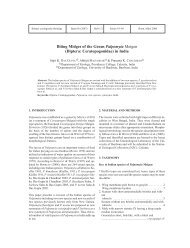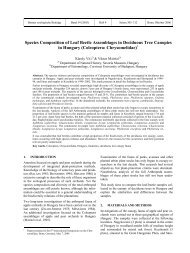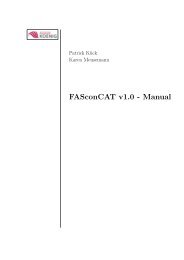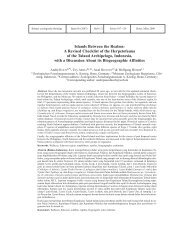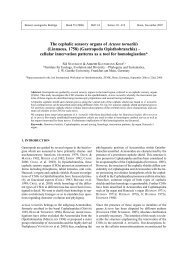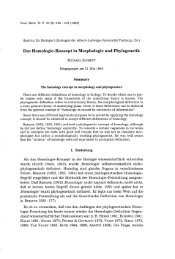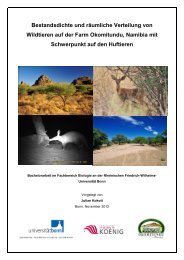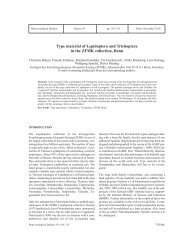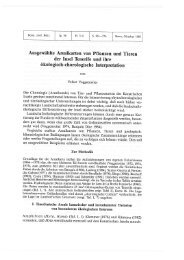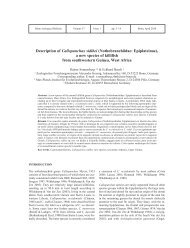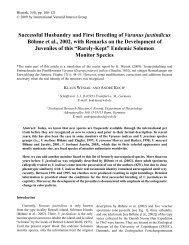Biogeography of the Sacoglossa (Mollusca, Opisthobranchia)*
Biogeography of the Sacoglossa (Mollusca, Opisthobranchia)*
Biogeography of the Sacoglossa (Mollusca, Opisthobranchia)*
Create successful ePaper yourself
Turn your PDF publications into a flip-book with our unique Google optimized e-Paper software.
258 Ka<strong>the</strong> R. JENSEN: <strong>Biogeography</strong> <strong>of</strong> <strong>Sacoglossa</strong><br />
Table 1. Number <strong>of</strong> species described by different authors (called<br />
“group(s)”, when with one or several co-authors) through time.<br />
All nominal taxa have been included.<br />
Author<br />
# species described<br />
Marcus (& Marcus), 1955–1982 39<br />
Baba (et al.), 1935–1959 30<br />
Jensen (et al.), 1980–1999 23<br />
Bergh, 1871–1905 20<br />
Pease, 1860–1871 17<br />
Ortea (et al.), 1981–2006 15<br />
Trinchese, 1869–1895 14<br />
Ichikawa, 1993 11<br />
Thompson (et al.), 1973–1988 10<br />
A. Costa, 1862-1876 10<br />
Total for 10 authors (groups) 189<br />
Total # nominal species 387<br />
Percentage described by 10 most productive<br />
authors (groups) 49<br />
Total # authors (groups) 104<br />
Average # species per author (group) 3.7<br />
ing <strong>the</strong> 19 th century is high, but many species have subsequently<br />
been synonymized. New species are still discovered<br />
(ORT E A & TE M P L A D O 1990; PE R R O N E 1990; CE RV E R A<br />
et al. 1991), old synonyms resurrected (CE RV E R A & LO P E Z-<br />
GONZÁLEZ 1996; ORTEA & MORO 1998), and <strong>the</strong> validity<br />
<strong>of</strong> some species, even some <strong>of</strong> <strong>the</strong> more recently described<br />
ones, is still debated (CERVERA et al. 2006). In addition,<br />
species ranges appear to be expanding (THOMPSON 1983;<br />
ORT E A et al. 1997; EV E RT S E N & BA K K E N 2002). Hence <strong>the</strong><br />
present analyses represent an ad hoc picture <strong>of</strong> species distributions<br />
and diversity.<br />
Three faunal provinces are recognized in <strong>the</strong> Nor<strong>the</strong>ast A t-<br />
lantic: <strong>the</strong> warm temperate Mediterranean Sea, including<br />
<strong>the</strong> Black and Azov Seas (no sacoglossans occur in <strong>the</strong><br />
Caspian and Aral Seas), <strong>the</strong> warm temperate Lusitanian<br />
province and <strong>the</strong> cold temperate Nor<strong>the</strong>ast Atlantic Boreal<br />
region (BRIGGS 1995). Three species appear to be endemic<br />
to <strong>the</strong> Nor<strong>the</strong>ast Atlantic cold-water region. However,<br />
two <strong>of</strong> <strong>the</strong>se may be identical to Lusitanian and/or<br />
Mediterranean species. The possible synonymy <strong>of</strong> E rc o l a -<br />
nia nigra and E. viridis is currently under study by <strong>the</strong><br />
present author, and it is also likely that Calliopaea oopha -<br />
Table 2. Species distribution and endemicity <strong>of</strong> sacoglossan opisthobranch in biogeographic regions as defined by BRIGGS (1995).<br />
Only species considered valid in <strong>the</strong> present study have been included. n.d. not determined.<br />
Region # Species # endemics (%)<br />
1. Nor<strong>the</strong>ast Atlantic boreal 11 3* (27)<br />
2. Lusitanian 40 5 (12.5)<br />
3. Mediterranean + Black Sea 37 8 (22)<br />
4. Northwest Atlantic boreal 6 1 (17)<br />
5. Caribbean incl. Florida 49 21 (43)<br />
6. Southwestern Atlantic tropical + warm temperate 19 3 (16)<br />
7. Aleutian 6 0<br />
8. Oregonian 8 0<br />
9. Californian 9 0<br />
10. Mexican-Panamanian 23 9 (39)<br />
11. Sou<strong>the</strong>ast Pacific warm temperate 6 0<br />
12. Cold temperate South America 4 2 (50)<br />
13. Northwest Pacific cold temperate 29 5 (17)<br />
14. Northwest Pacific warm temperate 41 9 (21)<br />
15. North and Northwestern Australia 23 4 (17)<br />
16. South and Southwestern Australia 22 6 (27)<br />
17. Sou<strong>the</strong>astern Australia 15 6 (40)<br />
18. Nor<strong>the</strong>astern Australia 18 1 (5.5)<br />
19. Great Barrier Reef 22 0<br />
20. New Zealand 5 1 (20)<br />
21. Sou<strong>the</strong>astern Atlantic 9 4 (44)<br />
22. Western Indian Ocean + Red Sea 32 8 (25)<br />
23. Indo-Polynesian, incl. Ryukyu Islands 107 n.d.<br />
24. Hawaii 25 6 (24)<br />
*Two <strong>of</strong> <strong>the</strong>se species may be synonymous with Lusitanian and Mediterranean species.




